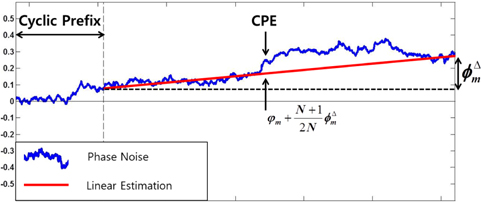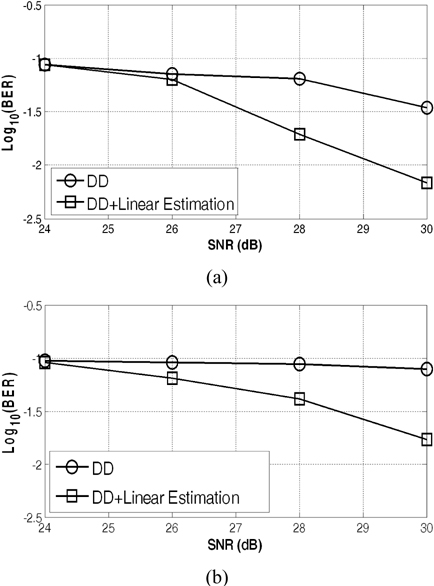



We propose a blind feedforward phase noise mitigation method in the time-domain for a coherent optical orthogonal frequency division multiplexing (CO-OFDM) systems. By exploiting the redundancy of the cyclic prefix (CP), the proposed scheme acquires the overall phase noise difference information during an OFDM block and attempts to mitigate the phase noise in the time domain using a linear approximation. The proposed algorithm mitigates common phase error (CPE) and inter-carrier-interference (ICI) due to phase noise simultaneously, improving the system performance, especially when decision-directed equalizers are used. The simulation results demonstrate the effectiveness of the proposed feedforward phase noise mitigation approach in time domain.
Coherent optical orthogonal frequency division multiplexing (CO-OFDM) is a highly effective technique to achieve highspeed optical communication systems for its high chromatic dispersion (CD) and polarization-mode dispersion (PMD) tolerance [1, 2]. However, CO-OFDM is vulnerable to the laser phase noise which destroys the orthogonality of the subcarriers. This loss of orthogonality results in inter-carrier-interference (ICI) and common phase error (CPE) in all subcarriers [3]. Since this distortion significantly degrades the system performance, various phase noise compensation techniques have been proposed.
These have mostly focused on frequency-domain phase noise mitigation, i.e., after removing the cyclic prefix (CP) and applying a fast Fourier transform (FFT), where pilot signals or decision direction (DD) methods are available. As mitigation of ICI requires sophisticated methods that incur considerable (indeed, prohibitive) computational expense [4], practical phase compensation studies have mainly considered only CPE mitigation based on either DD methods or high-order-statistics (HOS) blind-adaptive algorithms [5, 6].
In [7] a simple partial ICI mitigation approach has been considered. Using the CPE estimations from the post-discrete Fourier transform (DFT) signals, the algorithm linearly approximates the phase noise in an OFDM block and compensates for it in the frequency domain by convolving of the DFT version of the linear phase model [7]. Although this algorithm is, as far as we know, the simplest algorithm for reducing ICI distortion, it requires accurate CPE estimation from the corrupted data by the phase noise and post convolution processing cost due to its structure. Since the phase noise is a scalar multiplication in the time domain, a direct time-domain correction would be preferable.
In this paper, we propose a non-data-aided feedforward time domain phase noise mitigation scheme that reduces both CPE and ICI by exploiting the redundancy of the cyclic prefix (CP) structure. The CP is a copy of the last few samples of an OFDM block, which are inserted at the beginning of the block to sustain sub-carrier orthogonality over multipath channels. At the receiver, the CP structure guarantees that certain received samples match in the absence of phase noise. Based on this property, the phase difference between the beginning and the end of an OFDM block can be roughly estimated. We utilize this phase difference to compensate for ICI and CPE. Especially for systems with a DD equalizer, the proposed feedforward method alleviates the adverse effects of phase noise distortion on the DD equalizer and improves the overall performance.
The remainder of this paper is organized as follows. In Section 2, we describe the discrete time baseband OFDM system and the properties of the CP. In Section 3, we describe the proposed phase noise mitigation algorithm. The numerical results are shown in Section 4, and a conclusion is given in Section 5.
Let us consider a discrete time baseband CO-OFDM system model, where the
The purpose of CP is to maintain the orthogonality of the sub-carriers after multi-path channel transmission and the length of the CP,
for
as far as the CP length is set to meet the fundamental requirement of an OFDM system [11]. Note that in the presence of phase noise we can extract the phase difference between
We will exploit this to estimate and compensate for the phase noise in the OFDM blocks.
At the receiver, assuming perfect synchronization under proper distortion monitoring such as in [12, 13], the first
where
The principal phase distortion
III. PHASE NOISE MITIGATION SCHEME
Figure 1 shows a block diagram illustrating the proposed phase mitigation scheme. First, let us define an estimator for the phase noise difference between
Assuming that the first OFDM block (
The phase noise sequence
as shown in Fig. 2. This is the optimum mean square error (MSE) interpolation for the phase noise [10]. The phase-compensated signal, denoted by (
Regardless of the value of
Assuming mild phase noise, the CPE is can be approximated in the following manner [3]
Note that if
Given that
where
As
By updating the DD equalizer to compensate this CPE at every
We consider a 21.4Gb/s CO-OFDM system based on 16-QAM signals using 1024 subcarriers (
We have described a blind feedforward phase noise mitigation scheme. The proposed technique reduced both the CPE and ICI by using a linear approximation in the time domain The simulation results demonstrated that the proposed approach effectively improved system performance, especially when DD equalizers were used. In comparision with the conventional phase noise mitigation schemes, the pre-compensation approach of the proposed algorithm significantly improved the system performance with maginal computation load addition.


